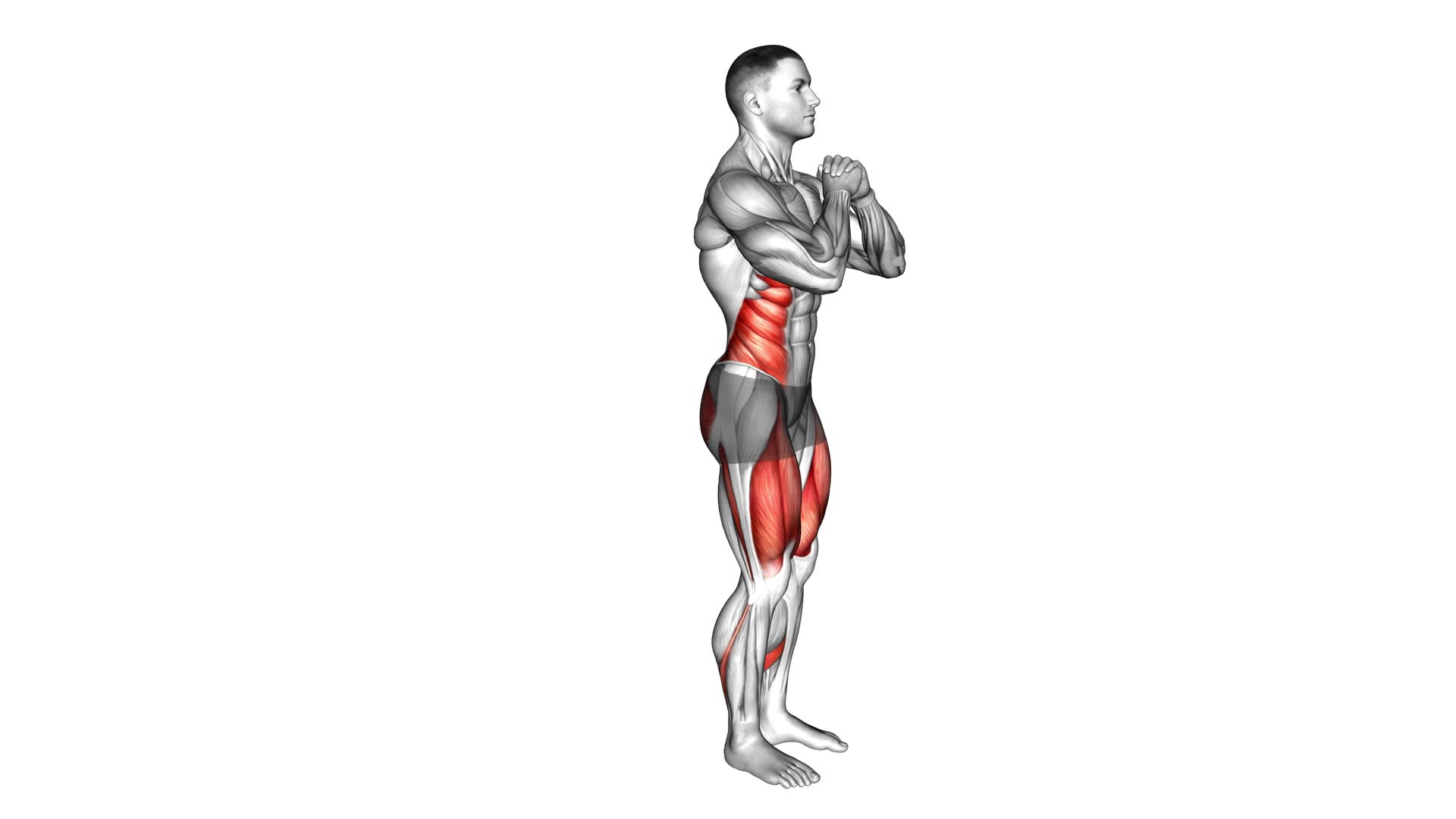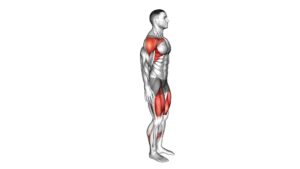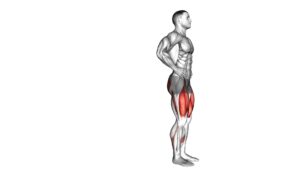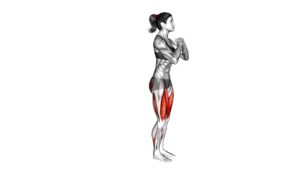Bodyweight Rear Lunge Twist (male) – Video Exercise Guide & Tips

Are you looking for a challenging lower body exercise that will engage multiple muscle groups?
Watch This Exercise Video
Then the bodyweight rear lunge twist is perfect for you!
In this video exercise guide, we'll show you the proper form and technique to maximize results.
With variations and modifications available, you can tailor this exercise to your fitness level.
Say goodbye to common mistakes and hello to a stronger, more toned physique.
Let's get started!
Key Takeaways
- Improved stability and flexibility
- Activation of multiple muscle groups
- Enhancement of balance and coordination
- Improvement of posture
Benefits of the Bodyweight Rear Lunge Twist
You will experience improved stability and flexibility with the Bodyweight Rear Lunge Twist. This exercise is a great way to activate your muscles and enhance your balance.
As you perform the movement, several muscle groups are engaged to stabilize your body. Your glutes, quadriceps, hamstrings, and calf muscles all work together to maintain your balance and control during the twist. By activating these muscles, you not only strengthen them but also improve their flexibility.
The Bodyweight Rear Lunge Twist also helps to improve your balance. As you step back into the lunge position and twist your torso, your body is challenged to maintain stability. This challenge forces your core muscles to engage in order to keep you upright. Additionally, the twisting motion requires coordination and control, further enhancing your balance.
The benefits of this exercise extend beyond just stability and flexibility. The Bodyweight Rear Lunge Twist can also help to improve your posture and strengthen your lower body. By incorporating this exercise into your routine, you can increase your overall body strength and enhance your athletic performance.
Proper Form and Technique
To perform the Bodyweight Rear Lunge Twist with proper form and technique, it's important to engage your core throughout the entire movement. This will help stabilize your body and prevent any unnecessary strain on your lower back.
Additionally, be mindful of common mistakes such as twisting too forcefully or lunging too far back, as these can lead to injuries.
Core Engagement Importance
Achieving proper form and technique in the Bodyweight Rear Lunge Twist (male) exercise is crucial for effective core engagement. The importance of core stability can't be understated when it comes to overall fitness and performance.
A strong core provides a solid foundation for all movements and helps prevent injury. Engaging your core during the Bodyweight Rear Lunge Twist exercise helps to stabilize your body and maintain proper alignment. It also enhances the effectiveness of the exercise by targeting and strengthening the muscles in your abs, obliques, and lower back.
For beginners, core exercises are essential for building a strong foundation. Incorporating exercises like planks, bird dogs, and bridges into your routine can help develop core strength and stability, which will improve your overall fitness and performance.
Preventing Common Mistakes
Maintaining proper form and technique plays a crucial role in preventing common mistakes during the Bodyweight Rear Lunge Twist (male) exercise.
To maximize results and engage your core effectively, it's important to pay attention to a few key factors.
First, ensure that your front knee stays directly above your ankle throughout the movement to avoid placing excessive strain on your knee joint.
Additionally, keep your torso upright and avoid leaning forward as you lunge to maintain proper alignment and engage your core muscles.
It's also essential to maintain a controlled and smooth motion, avoiding any jerky or quick movements that can compromise your form.
Variations and Modifications
You can modify the bodyweight rear lunge twist exercise to suit your fitness level and goals. There are several variations and modifications you can try to make the exercise more challenging or easier, depending on your needs.
One variation you can do is to hold a dumbbell or kettlebell in each hand while performing the rear lunge twist. This will add resistance and increase the difficulty of the exercise, targeting your leg muscles and core even more.
If you find it difficult to maintain your balance during the exercise, you can try using a wall or a chair for support. Simply place your hand on the wall or hold onto the back of a chair while performing the rear lunge twist. This modification will help you stabilize your body and prevent any falls or injuries.
Another modification you can make is to reduce the range of motion. Instead of stepping back into a deep lunge, you can take smaller steps and perform a shallow lunge twist. This will be less demanding on your leg muscles and allow you to focus more on your core and balance.
Remember to always listen to your body and choose the modifications that work best for you. By adjusting the bodyweight rear lunge twist exercise, you can tailor it to your fitness level and continue challenging yourself as you progress.
Muscle Groups Targeted
The bodyweight rear lunge twist exercise primarily targets multiple muscle groups in your lower body. This exercise is a great way to work your glutes, quadriceps, hamstrings, and calves. It also engages your core muscles, including your abdominals and obliques. By performing this exercise regularly, you can strengthen and tone these muscle groups, improving your overall lower body strength and stability.
To maximize the effectiveness of the bodyweight rear lunge twist exercise, it's important to have good hip flexibility. This allows you to perform the exercise with a full range of motion and engage your muscles properly. Incorporating hip stretches, such as hip flexor stretches and hip rotator stretches, into your warm-up routine can help improve your hip flexibility.
In addition to targeting specific muscle groups, the bodyweight rear lunge twist exercise also helps to improve balance and stability. The twisting motion engages your core muscles and challenges your balance, forcing your body to stabilize itself. By practicing this exercise regularly, you can increase your proprioception and improve your overall balance and stability.
Incorporating the bodyweight rear lunge twist exercise into your workout routine can be a great way to strengthen your lower body muscles, improve hip flexibility, and enhance your balance and stability. Remember to always maintain proper form and technique to avoid injury and maximize the benefits of this exercise.
Common Mistakes to Avoid
To ensure proper execution of the bodyweight rear lunge twist exercise and avoid potential mistakes, it's crucial to focus on maintaining balance and stability throughout the movement. By doing so, you can prevent injuries and improve your overall balance.
One common mistake to avoid is rushing through the exercise. Take your time and perform each lunge with control and precision.
Another mistake isn't keeping your core engaged. Your core plays a vital role in providing stability and preventing injuries. Remember to keep your abs tight throughout the movement.
Additionally, it's important to maintain proper alignment. Avoid leaning too far forward or backward during the lunge, as this can put unnecessary strain on your knees and lower back.
Lastly, don't forget to breathe. It's easy to hold your breath during challenging exercises, but proper breathing helps with stability and endurance. By avoiding these common mistakes, you can perform the bodyweight rear lunge twist exercise safely and effectively.
Now, let's move on to some tips for maximizing your results.
Tips for Maximizing Results
To maximize your results with the bodyweight rear lunge twist exercise, it's crucial to focus on proper form techniques.
Make sure to maintain a straight back, engage your core, and keep your knee aligned with your ankle during the lunge.
Additionally, to achieve targeted muscle activation, concentrate on engaging your glutes and core while performing the twist movement.
Proper Form Techniques
Maximize your results by incorporating proper form techniques into your bodyweight rear lunge twist. To ensure you get the most out of this exercise, here are some tips to keep in mind:
- Maintain proper alignment: Keep your back straight and your core engaged throughout the movement. This will help prevent any unnecessary strain on your lower back.
- Avoid common misconceptions: One common misconception is that you need to twist your torso forcefully. Instead, focus on controlled and smooth movements to avoid injury.
- Use injury prevention techniques: Before performing the bodyweight rear lunge twist, make sure to warm up your muscles and joints. Additionally, listen to your body and stop if you feel any pain or discomfort.
Targeted Muscle Activation
To maximize your results with the bodyweight rear lunge twist, engage the muscles of the targeted leg and core throughout the exercise. By activating these muscles, you'll increase the intensity and effectiveness of the exercise.
The bodyweight rear lunge twist primarily targets the quadriceps, hamstrings, glutes, and core muscles. Engaging these muscles won't only help you build strength and increase muscle tone but also improve stability and balance.
Additionally, by activating your core muscles, you'll enhance your overall posture and body control.
To further maximize your muscle activation benefits, you can modify the exercise by using dumbbells or resistance bands. Adding resistance will increase the workload on your muscles, leading to greater muscle activation and ultimately better results.
Frequently Asked Questions
How Many Reps and Sets Should I Do for the Bodyweight Rear Lunge Twist Exercise?
For the bodyweight rear lunge twist exercise, it's important to focus on your reps and sets. Start with 2-3 sets of 8-12 reps on each leg. This will help build strength and stability.
Remember to listen to your body and modify the exercise if you have any injuries. If needed, you can reduce the number of reps or perform the exercise with a shorter range of motion.
Always prioritize safety and proper form during your workout.
Can I Do the Bodyweight Rear Lunge Twist if I Have Knee or Hip Issues?
If you have knee or hip issues, it's important to be cautious when performing the bodyweight rear lunge twist exercise. There are alternative exercises you can try that put less strain on these areas, such as seated leg lifts or standing hip abduction exercises.
Additionally, you can modify the bodyweight rear lunge twist by reducing the range of motion or using a support like a chair or wall for stability.
Always listen to your body and consult with a healthcare professional if needed.
Is It Better to Perform the Bodyweight Rear Lunge Twist With Weights or Without?
When it comes to the bodyweight rear lunge twist, you might be wondering whether it's better to perform with weights or without.
Adding weights to bodyweight exercises can provide additional resistance, helping to increase muscle strength and challenge your body even more. This can lead to greater benefits, such as improved balance, stability, and overall fitness.
However, it's important to listen to your body and consult with a professional if you have any concerns or pre-existing knee or hip issues.
How Often Should I Incorporate the Bodyweight Rear Lunge Twist Into My Workout Routine?
To determine how often you should incorporate the bodyweight rear lunge twist into your workout routine, consider your fitness goals and current level of fitness.
As a general guideline, aim to perform this exercise 2-3 times per week.
The bodyweight rear lunge twist can help improve your balance and stability by engaging your core and lower body muscles.
It's important to maintain proper form and gradually increase the intensity as you progress.
Can the Bodyweight Rear Lunge Twist Help Improve My Balance and Stability?
Improving balance and stability is important for overall fitness. Bodyweight exercises can be a great way to achieve this.
The Bodyweight Rear Lunge Twist is one exercise that can help improve your balance and stability. It challenges your core and lower body muscles while requiring coordination and control.
If you're looking for alternative exercises to improve balance and stability, you can also try single-leg exercises like the Single-Leg Deadlift or the Bulgarian Split Squat.
Conclusion
In conclusion, the bodyweight rear lunge twist is a highly effective exercise that targets multiple muscle groups and improves overall strength and stability.
By following proper form and technique, avoiding common mistakes, and incorporating variations and modifications, you can maximize your results and enhance your fitness routine.
Remember to always consult with a fitness professional before starting any new exercise program.

Author
Years ago, the spark of my life’s passion ignited in my mind the moment I stepped into the local gym for the first time. The inaugural bead of perspiration, the initial endeavor, the very first surge of endorphins, and a sense of pride that washed over me post-workout marked the beginning of my deep-seated interest in strength sports, fitness, and sports nutrition. This very curiosity blossomed rapidly into a profound fascination, propelling me to earn a Master’s degree in Physical Education from the Academy of Physical Education in Krakow, followed by a Sports Manager diploma from the Jagiellonian University. My journey of growth led me to gain more specialized qualifications, such as being a certified personal trainer with a focus on sports dietetics, a lifeguard, and an instructor for wellness and corrective gymnastics. Theoretical knowledge paired seamlessly with practical experience, reinforcing my belief that the transformation of individuals under my guidance was also a reflection of my personal growth. This belief holds true even today. Each day, I strive to push the boundaries and explore new realms. These realms gently elevate me to greater heights. The unique combination of passion for my field and the continuous quest for growth fuels my drive to break new ground.



